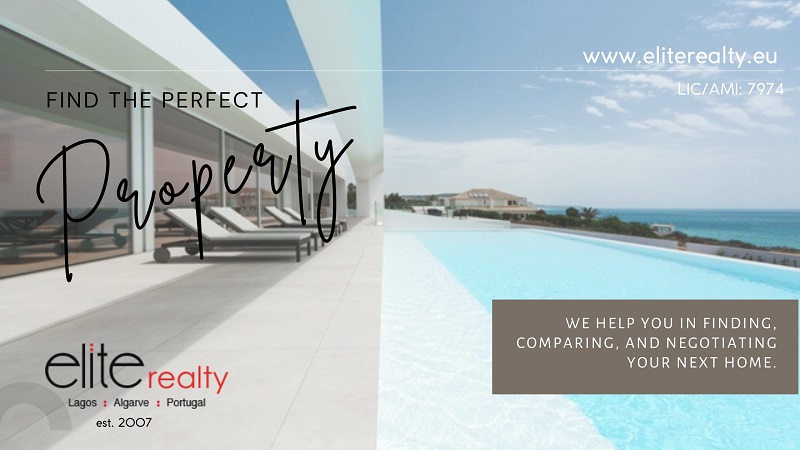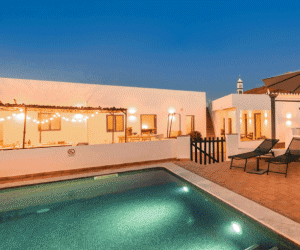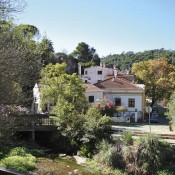
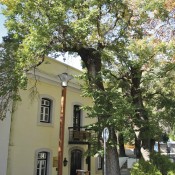
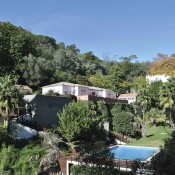
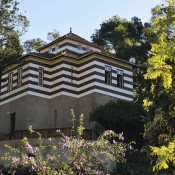
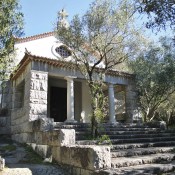
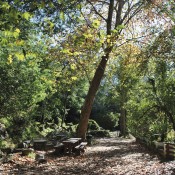 THE LITTLE PICTURESQUE SPA TOWN OF CALDAS DE MONCHIQUE IS THE ANTITHESIS OF THE ALGARVE’S SEASIDE RESORTS
THE LITTLE PICTURESQUE SPA TOWN OF CALDAS DE MONCHIQUE IS THE ANTITHESIS OF THE ALGARVE’S SEASIDE RESORTS
In Caldas de Monchique, it is easy to think that you are in a different region of Portugal, or even in another country. It is hard to believe that the beach and the sea are a mere 30 kilometres away. Thanks to the humid and mild, sub- tropical maritime mountain climate, the fertile granite soil and the many springs and watercourses, the flora of this town sit- uated at 350 metres above sea level is very different to that of the rest of the Algarve. Besides typical Mediterranean plants, such as oaks and strawberry trees, the specific microclimate also allows for trees and plants that normally grow in more humid climates, such as pine, chestnut and plane trees, or camellias. Many of the lush, densely-packed trees grow to a height of about ten metres and the trunks reach up to two me- ters in diameter. But it’s not only the flora that is different; the buildings in Caldas are not typical for the Algarve and hint at a grand and noble past. All this and much more can be dis- covered on a two-kilometre round tour of Caldas.
We leave the car at the entrance road and walk the few metres to the main square. From there we follow the road to the right and soon reach the Chapel of Santa Teresa, built in 1940,
which is made entirely of syenite, an igneous rock that is very common here and therefore perfectly integrated into the landscape. Inside the single-nave chapel there are several tile panels dating from the 18th century, depicting the life of Santa Teresa. The main façade is decorated with a round window, a doorway with a stone frame and a portico supported by pillars. A small park with wooden bridges spanning the stream has been created around the chapel.
After going round the chapel, we follow the trail directly below the slowly-decaying building to the right of the chapel, and then under the many-century-old, crooked-grown oak, up to the other park of Caldas de Monchique. There are two to three paths leading to this artificially created, exuberantly- growing park. The path to the far right is not suitable for people with reduced mobility.
The paths lead past watercourses, pools and springs. Aquatic plants similar to water lilies, creepers, herbs, cacti, and colourful flowers and moss on the walls grow in the shade of plane trees, chestnut trees, acacias and eucalyptus trees. Among the plant life there are natural stone steps, granite pool surrounds, tables and benches, inviting you to stay and have a picnic, a labyrinth of narrow and wide channels, as well as large and small pools guiding the water down the gentle slope, and wooden bridges – in short: orderly wilderness.
Around a dozen springs feed the streams, whose origin may lie high up in the Serra de Monchique. Practically each one of these springs is connected to a popular belief. Such as, for example, the Lovers’ Spring, which flows out of a small pipe on a stone wall in the northern part of the park, below an unsightly green metal door. The lover should return several times to say the name of their beloved and drink from the water, so that the love will be heard or will remain. I’m considering whether I should fill my water bottle with this water, but a few metres further south the Spring of Youth is flowing into a small natural pool. Its water is meant to rejuvenate regular drinkers by six years each year. I’m already in love and married, but I’m certainly not getting any younger. So perhaps I better bottle some of this water, instead?
Lost in these thoughts, I soon reach the main square. Coins and other items, which were found at the site of the spa, where the modern spa is now located, prove that the Romans already used the local springs, the sulphur-rich, 32oC-warm water of which is said to have therapeutic properties, especially beneficial for sufferers of respiratory diseases and rheumatism. After the Romans left, the place became somewhat forgotten. The Moors were apparently not that interested in the springs. The history of the spa town is only reprised in 1495, when King João II tried to cure his ailments here. Unfortunately, without success. He died in October 1495, in Alvor. Four years later Vasco da Gama opened up the sea route to India, in accordance with the late king’s plans. Shortly afterwards Pedro Álvares Cabral discovered Brazil. The discoveries were in full swing and from Caldas it was a mere three-day trip to Sagres, from where Henry the Navigator sent the explorers into the wide unknown world. Caldas thus became an increasingly popular destination for secular and spiritual nobility.
After the great earthquake, in November 1755, Bishop Dom Francisco Gomes de Avelar ordered some improvements in the town. In 1773 Caldas de Monchique received the status of small town (Vila). In 1789 the medical properties of the water were examined professionally for the first time and the positive results led to the construction of a hospital. From 1833, the management of the hospital was also responsible for the welfare of the poor population. Seven years later it was nationalised; in 1869 a decree followed, which required a doctor’s visit, before and after bathing in the springs. In 1899 the scientist Professor Charles Lepierre examined the spring water with the result: “This has the highest mineral content of any water I’ve experienced!”
During the Salazar dictatorship the place lost its charisma. With the Carnation Revolution, in 1974, the town was handed over to state-run Pousada owner Enatour. The houses and the spa were increasingly deteriorating in condition. In 1993 Enatour put the majority of the site up for sale. One year later the Fundação Oriente, a development company of a Macau- born Chinese, bought it. After nearly four years of construction work, the Termas de Monchique hot springs were reopened, in May 2000. Not only did the thermal springs become the best known in the country, but Caldas de Monchique has since developed into one of the region’s most popular attractions. Hardly surprising, since the small town is a haven of peace and the park is an idyllic retreat.
Most of the buildings in the village centre are owned by the foundation, which operates the thermal baths and serve as accommodation for guests. There are also restaurants, a café and a handicrafts shop, as well as manicured gardens with lush green lawns. It’s not just the former aristocratic residences resembling small palaces that attract our attention. The small details are just as fascinating, such as the retro street lighting, stone-framed windows or even the cute dwellings of Pernalta (“longleg”) the tom-cat.
The walk then continues behind the building with the Arab windows, under the arcades and then along the slope below the EN 266. We now look onto the pool of the thermal spas hotel and the three-storey building that doesn’t fit within the landscape and the small village at all. Following the cobbled street in front of the hotel’s entrance, we soon pass the filling facility for Monchique’s famed mineral water. The large halls, in which the sulphur flavour is extracted from the water, are even more unsightly than the hotel and would better suit an industrial area. One must, however, try to see the positive side, as the filling facility provides jobs for the local population and the nationwide distribution of its water further shines the spotlight on Monchique. Finally we take the wide path right back to the centre and shortly afterwards relax in front of the Taberna with a glass of wine, looking onto the traditional oven.
You don’t need to visit the thermal spa in order to feel good and recharge your batteries, a walk through the park and the town is more than enough to achieve this. Especially if you stop in one of the many restaurants along the road on your way home and try something tasty from the mountains, such as cured ham, sausages or ‘migas’ with pork, just as my grandmother used to make!
TEXT & PHOTOS ANABELA GASPAR


